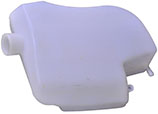1. The process of injection molding and blow molding is different. Blow molding is injection + blowing; injection molding is injection + pressure; blow molding must have the head left by the blowing pipe, and injection molding must have Gate section
2. Generally speaking, injection molding is a solid core body, blow molding is a hollow core body, and the appearance of blow molding is uneven. Blow molding has a blowing port.
3. Injection molding, that is, thermoplastic injection molding, in which the plastic material is melted and then injected into the film cavity. Once the molten plastic enters the mold, it is cooled into a cavity-like shape. The resulting shape is often the final product and no further processing is required before the equipment or use as the final product. Many details, such as bosses, ribs, and threads, can be formed in a single injection molding operation. An injection molding machine has two basic components: an injection device that melts and feeds the plastic into the mold, and a clamping device. The effect of the mold equipment is:
1. The mold is closed under the condition of receiving the injection pressure.
2. Take the product out of the injection equipment to melt the plastic before it is injected into the mold, and then control the pressure and speed to inject the melt into the mold. There are two types of injection equipment used today: screw pre-plasticizer or two-stage equipment, and reciprocating screw. Screw pre-plasticizers use a pre-plasticizing screw (first stage) to inject molten plastic into an injection rod (second stage). The benefits of the screw pre-plasticizer are stable melt quality, high pressure and high speed, and precise injection volume control (using mechanical thrust devices at both ends of the piston stroke).
These benefits are required for clear, thin-walled products and high production rates. Disadvantages include uneven residence time (leading to material degradation), higher equipment costs and maintenance costs. The more commonly used reciprocating screw injection devices do not require a plunger to melt and inject the plastic.

Blow molding: also known as hollow blow molding, blow molding, a rapidly developing plastic processing method. The tubular plastic parison obtained by extrusion or injection molding of thermoplastic resin is placed in a split mold while it is hot (or heated to a softened state), and compressed air is introduced into the parison immediately after closing the mold to blow the plastic parison. It expands and sticks closely to the inner wall of the mold, and after cooling and demolding, various hollow products are obtained. The production process of blown film is very similar in principle to blow molding of hollow products, but it does not use a mold. From the perspective of plastic processing technology classification, the molding process of blown film is usually included in extrusion. The blow molding process was first used to produce low-density polyethylene vials during World War II. In the late 1950s, with the birth of high-density polyethylene and the development of blow molding machines, blow molding skills were widely used. The volume of hollow containers can reach thousands of liters, and some production has adopted computer control. Plastics suitable for blow molding include polyethylene, polyvinyl chloride, polypropylene, polyester, etc., and the obtained hollow containers are widely used as industrial packaging containers.
Post time: Jun-20-2023
